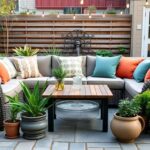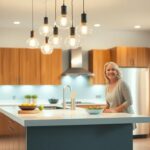We’ve all dreamed of hosting the perfect outdoor gathering where guests mingle effortlessly while we prepare delicious meals under the open sky. An L-shaped outdoor kitchen transforms this dream into reality by maximizing both functionality and social flow in ways traditional linear designs simply can’t match.
The genius of L-shaped outdoor kitchens lies in their ability to create distinct zones while maintaining seamless workflow. We can position cooking appliances along one arm while dedicating the perpendicular section to prep work and serving areas. This configuration naturally opens toward your patio or yard creating an inviting entertainment hub that keeps us connected with guests.
Whether you’re working with a compact space or expansive backyard we’ll explore creative L-shaped designs that make the most of every square foot. From budget-friendly DIY answers to luxury installations these versatile layouts prove that smart design beats size every time when it comes to outdoor culinary success.
L Shape Outdoor Kitchen Layout: Maximizing Corner Space and Functionality
The L shaped configuration transforms corner spaces into highly functional cooking environments that optimize every square foot of your outdoor area.
Strategic Corner Placement for Optimal Traffic Flow
Positioning the corner unit strategically creates natural pathways that keep guests and cooks moving smoothly throughout your outdoor space. We recommend placing the corner at the intersection of your main traffic areas to establish clear walking zones around the kitchen perimeter.
Designing the work triangle becomes more efficient when you position the grill on one arm of the L shape and the sink or prep area on the other arm. This configuration reduces walking distances between key cooking stations while maintaining adequate workspace for food preparation.
Creating buffer zones around the corner prevents bottlenecks during busy cooking sessions. We suggest maintaining at least 42 inches of clearance behind the cook to allow comfortable movement and prevent crowding when multiple people use the kitchen simultaneously.
Installing the corner appliance thoughtfully maximizes accessibility from both sides of the L configuration. Corner sinks work exceptionally well because they provide easy access to plumbing connections while creating a natural focal point for the entire outdoor kitchen layout.
Creating Defined Work Zones in L-Shaped Configurations
Establishing the prep zone on the shorter arm of the L shape keeps food preparation separate from high heat cooking areas. We typically allocate 24 to 36 inches of counter space for chopping, mixing, and plating activities that support the main cooking operations.
Positioning the cooking zone along the longer arm accommodates larger grills, smokers, and side burners that require more horizontal space. This arrangement provides sufficient room for multiple cooking methods while keeping heat sources concentrated in one area.
Organizing the cleanup station near the corner maximizes plumbing efficiency and creates a natural endpoint for the cooking process. We recommend incorporating a sink, storage for cleaning supplies, and adequate counter space for dish staging in this dedicated zone.
Integrating the serving area at the open end of the L configuration creates seamless transitions between cooking and entertaining spaces. This placement allows cooks to interact with guests while maintaining clear separation between active cooking zones and social areas.
Built-In Grill Station Ideas for Your L Shape Outdoor Kitchen
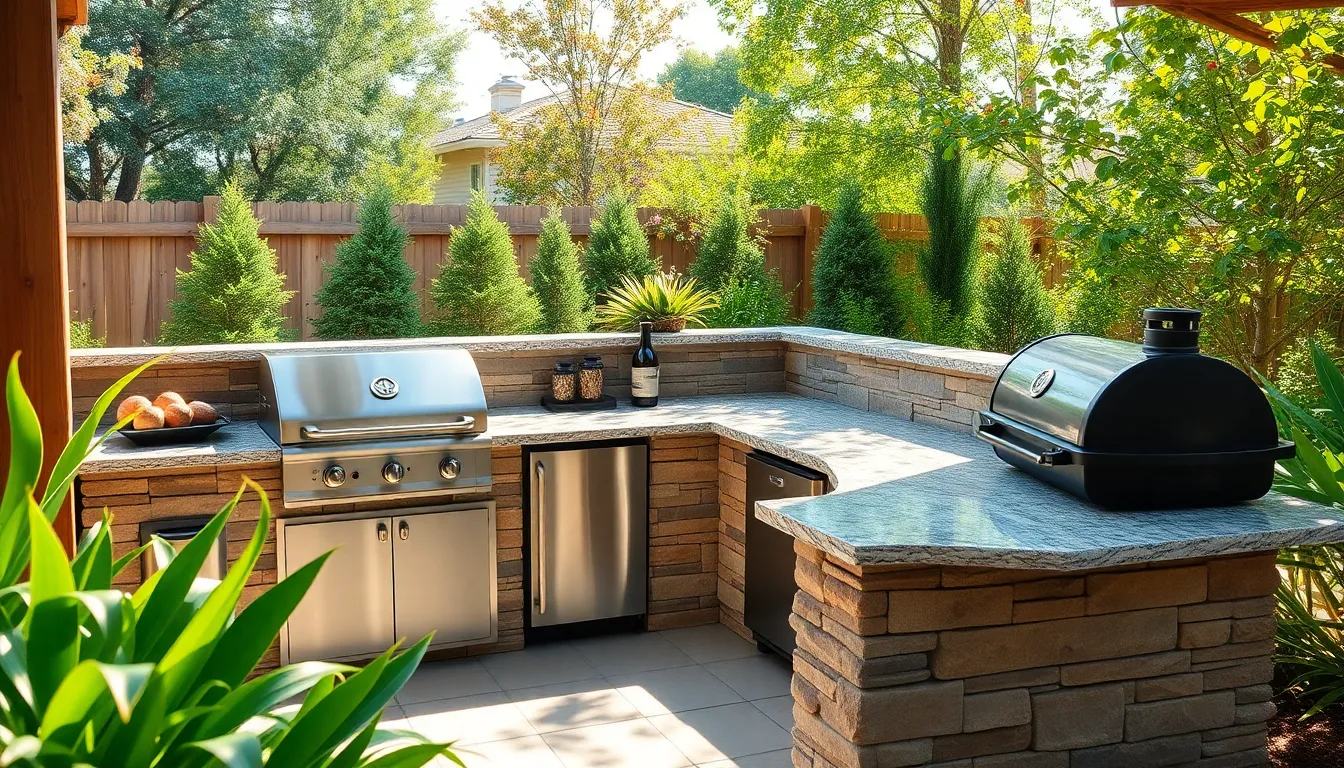
Building your grill station into the L shaped design creates a seamless cooking hub that elevates both functionality and style. We’ll explore how different grill types and custom elements transform your outdoor kitchen into an entertainment centerpiece.
Gas Grill Integration with Custom Countertops
Gas grills serve as the central appliance in one leg of the L configuration, creating a streamlined cooking station that handles multiple dishes simultaneously. We recommend placing the grill within the L layout to enable efficient workflow during outdoor entertaining sessions.
Custom countertops extending on both sides of the grill maximize prep and serving space while providing weather resistant surfaces. Materials like granite or concrete offer ample surface area for food preparation, plating, and serving needs. These durable options withstand outdoor conditions while maintaining their aesthetic appeal year round.
Storage access doors positioned beneath the grill area consolidate cooking essentials in one convenient zone. We suggest incorporating a refrigerator nearby to complete your cooking triangle and minimize steps between food storage and preparation areas.
Contrasting designs create visual interest that enhances your outdoor kitchen’s aesthetic appeal. Dark grills paired with light stone finishes provide striking visual balance while natural materials like stone or tile blend rustic and contemporary styles effectively.
Charcoal and Smoker Options for Enhanced Flavor
Charcoal grills and smokers positioned within the L layout allow for diverse cooking methods that gas grills cannot replicate. We recommend strategic placement at the corner section to balance functionality with guest interaction while separating heat zones effectively.
Wood fired flavors and slow smoking capabilities elevate your outdoor cooking experience beyond standard grilling options. These cooking methods produce distinctive tastes that appeal to culinary enthusiasts seeking authentic barbecue experiences.
Combining gas and charcoal options caters to different cooking preferences while maximizing your kitchen’s versatility. We suggest positioning a charcoal smoker in the corner or opposite leg of the L to add variety without compromising workflow efficiency.
Integration of wood fired pizza ovens alongside traditional grilling equipment creates a comprehensive cooking station. This combination allows hosts to prepare multiple course meals while entertaining guests in the outdoor space.
Storage Solutions That Work Best in L Shape Outdoor Kitchen Designs
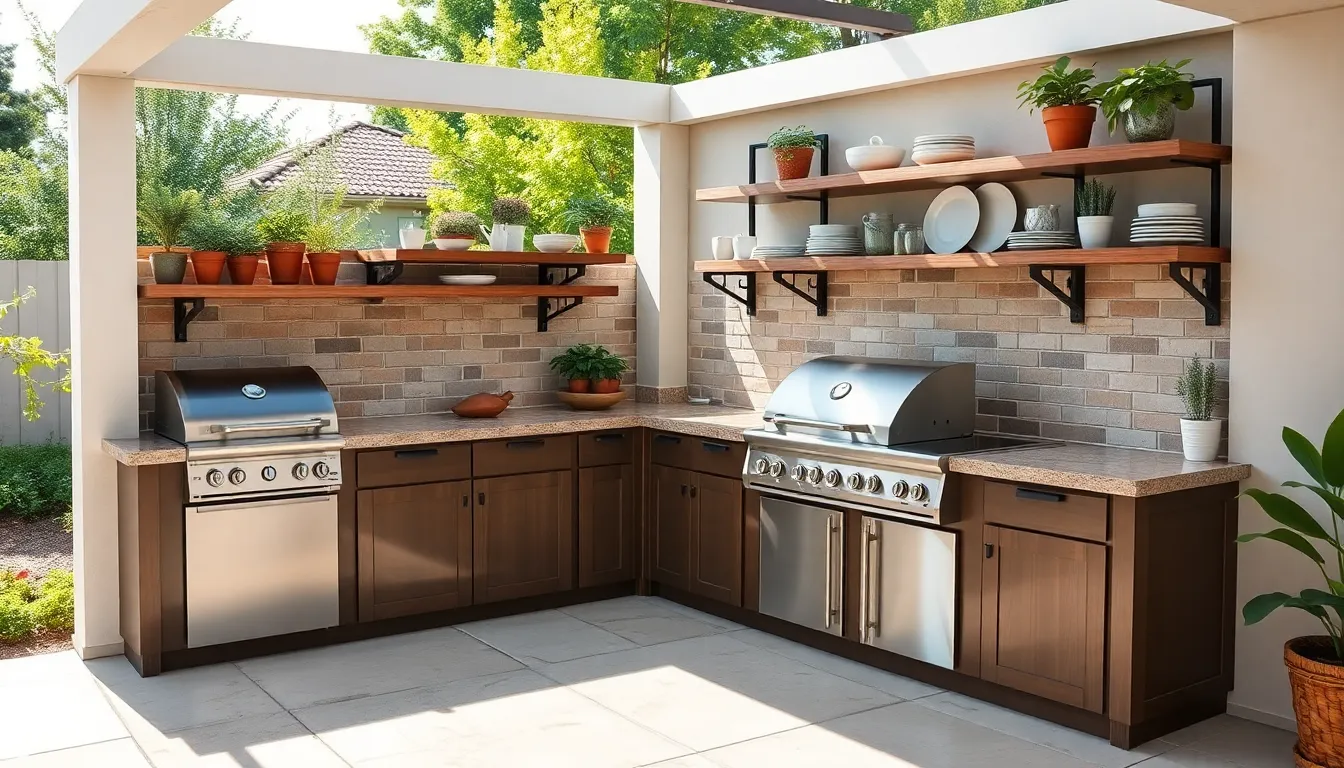
Smart storage transforms your L shape outdoor kitchen from a simple cooking space into an organized culinary command center. We’ll explore the most effective storage strategies that capitalize on this layout’s unique advantages.
Corner Cabinet Systems for Maximum Storage
Corner cabinet systems turn the most challenging space in your L shape outdoor kitchen into its most valuable storage asset. We recommend installing pull-out shelves that bring items from the back corner directly to you, eliminating the need to reach into dark, hard-to-access spaces. Lazy Susans work exceptionally well for storing condiments, spices, and smaller cooking accessories, allowing everything to rotate within easy reach.
Swing-out racks maximize vertical storage while keeping your grilling tools, utensils, and cookware organized in dedicated compartments. These systems typically increase storage capacity by 40-60% compared to traditional fixed shelving. We’ve found that homeowners who install corner cabinet systems report significantly improved kitchen efficiency and reduced cooking preparation time.
Open Shelving and Display Areas
Open shelving creates visual breathing room while keeping frequently used items within arm’s reach throughout your cooking process. We suggest positioning open shelves on the shorter arm of your L shape layout, where they’re easily accessible during food preparation but won’t interfere with your primary cooking zone.
Display areas serve dual purposes by showcasing decorative elements like potted herbs, attractive serving dishes, or outdoor-friendly artwork while maintaining functionality. Plants such as rosemary, thyme, and basil thrive in outdoor kitchen environments and provide fresh ingredients for your cooking. We recommend spacing shelves 12-15 inches apart to accommodate various item heights while maintaining clean visual lines that complement your overall design aesthetic.
Weather-Resistant Storage Materials
Weather-resistant materials ensure your storage answers withstand outdoor conditions while maintaining their appearance and functionality year-round. We prioritize stainless steel for its superior rust resistance and easy maintenance, particularly in coastal areas where salt air accelerates corrosion.
Marine-grade polymer cabinets offer excellent durability without the weight concerns of metal construction, making them ideal for structures with weight limitations. Treated wood options like teak or cedar provide natural weather resistance while adding warmth to your outdoor kitchen design. Weatherproof composite materials combine the best features of wood and synthetic materials, offering wood-like appearance with enhanced moisture and UV protection.
| Material Type | Durability Rating | Maintenance Level | Cost Range |
|---|---|---|---|
| Stainless Steel | Excellent | Low | $$$ |
| Marine-Grade Polymer | Excellent | Very Low | $$$$ |
| Treated Teak | Very Good | Medium | $$$$$ |
| Weatherproof Composite | Very Good | Low | $$ |
These materials maintain their structural integrity and visual appeal across temperature fluctuations, humidity changes, and direct sun exposure that characterize outdoor environments.
Countertop Materials Perfect for L Shape Outdoor Kitchen Ideas
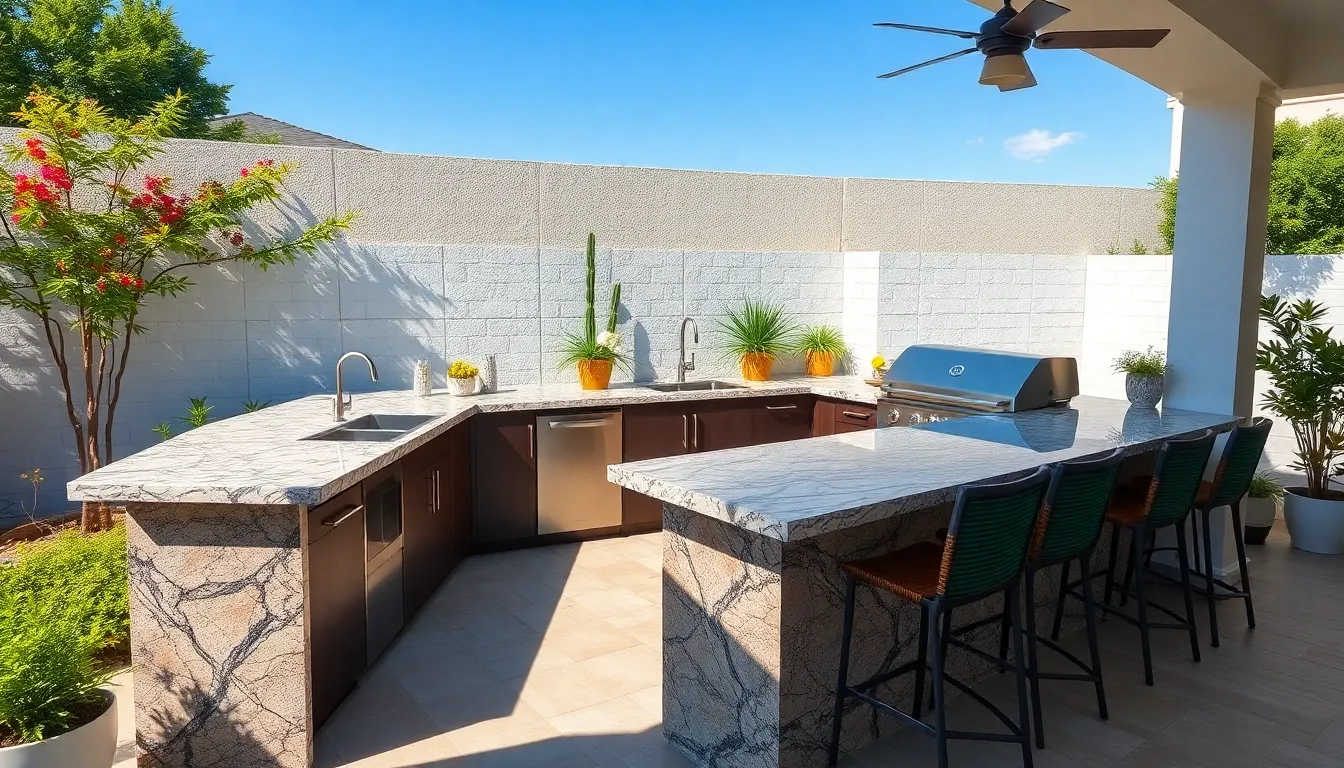
Choosing the right countertop materials for your L shaped outdoor kitchen makes the difference between a surface that lasts decades and one that needs constant replacement. We’ll explore the best options that combine durability with stunning aesthetics.
Natural Stone Options for Durability
Granite stands as our top recommendation for L shaped outdoor kitchen countertops because it withstands extreme weather conditions while maintaining its polished appearance. This natural stone resists heat damage from hot pans and grilling equipment, making it perfect for the cooking zones in your L configuration. Marble offers another excellent choice, particularly for prep areas where its naturally cool surface helps with food preparation tasks like rolling dough or working with pastry.
Stone materials like granite and marble provide unmatched durability that can handle the demands of outdoor cooking year after year. We’ve seen these surfaces maintain their beauty through harsh winters and scorching summers without cracking or fading. Natural stone also adds important value to your outdoor kitchen investment, creating a classic look that never goes out of style.
Weather resistance becomes crucial when your countertops face constant exposure to rain, snow, and UV rays. Granite’s dense composition makes it naturally resistant to moisture penetration, while proper sealing ensures long term protection against staining and weathering.
Concrete Countertops for Modern Appeal
Concrete delivers a contemporary aesthetic that complements the clean lines of L shaped outdoor kitchen designs perfectly. We can customize concrete surfaces to match any color scheme or design vision, making them ideal for homeowners who want a truly personalized outdoor cooking space. This material offers exceptional flexibility in terms of shape and thickness, allowing us to create seamless countertops that follow the exact contours of your L configuration.
Modern concrete countertops can be sealed specifically for outdoor use, providing protection against weather damage and staining. The material’s ability to be molded into any shape makes it particularly valuable for corner sections where traditional materials might require joints or seams. Concrete also integrates beautifully with other outdoor kitchen elements like fire features and water elements.
Customization options with concrete extend beyond just color and shape to include embedded decorative elements like glass chips or metallic accents. We can create unique textures and finishes that enhance your outdoor kitchen’s visual appeal while maintaining the durability needed for year round use.
Tile and Composite Material Considerations
Tile surfaces offer incredible versatility for L shaped outdoor kitchens, allowing us to create patterns and designs that complement your home’s architecture. Porcelain tiles designed for outdoor use provide excellent durability while offering the appearance of natural stone or wood at a more accessible price point. These materials resist fading, cracking, and moisture damage when properly installed with appropriate outdoor rated adhesives and grouts.
Composite materials like quartz engineered surfaces bring together the beauty of natural stone with enhanced durability and lower maintenance requirements. We often recommend these materials for busy outdoor kitchens because they resist staining and don’t require periodic sealing like natural stone options.
Installation advantages make tile and composite materials appealing choices for DIY enthusiasts or projects with tighter timelines. These materials are often easier to work with than heavy natural stone slabs, and repairs or replacements can be completed in sections rather than requiring full countertop replacement. Maintenance becomes simpler with these materials, requiring only regular cleaning with mild detergents rather than specialized stone care products.
Sink and Prep Area Integration in L Shape Outdoor Kitchen Layouts
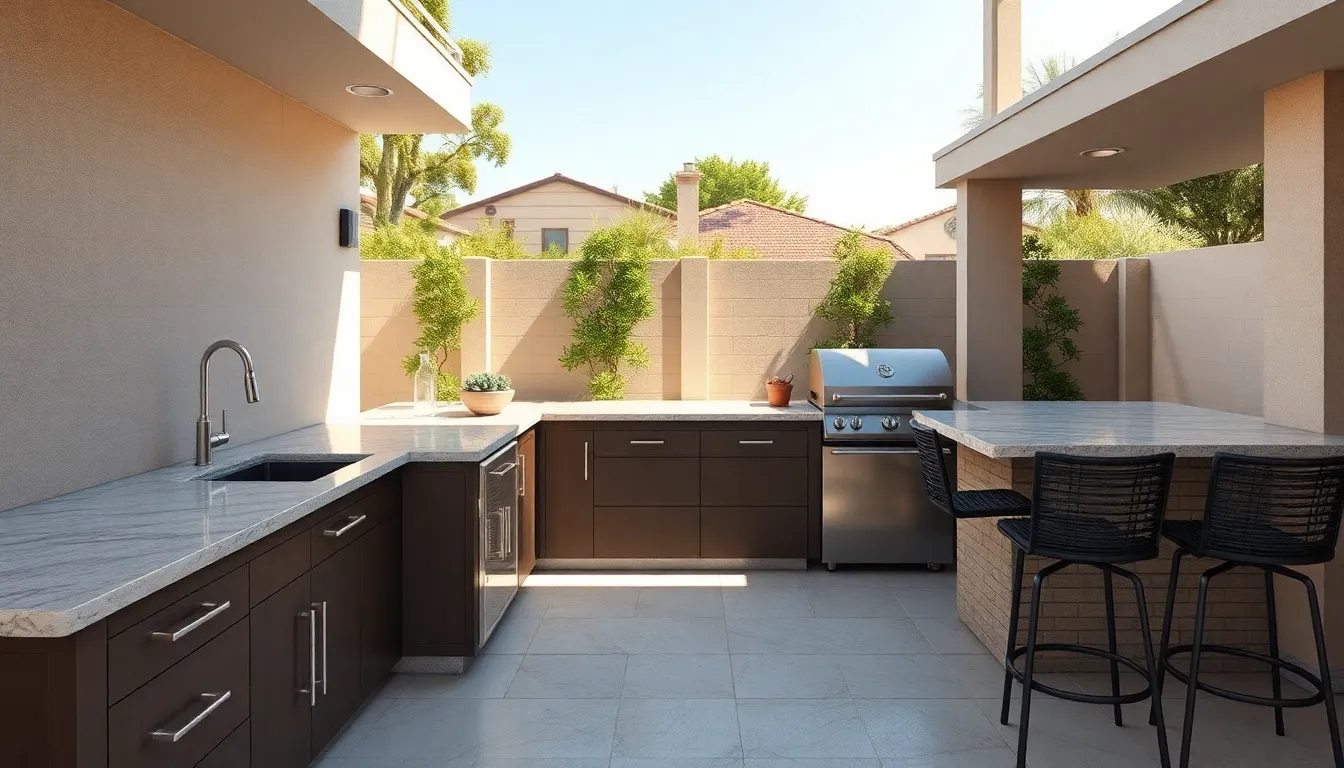
Effective sink and prep area integration transforms your L shaped outdoor kitchen into a seamless culinary workspace. Smart placement creates an efficient work triangle that enhances both functionality and social interaction.
Corner Sink Placement Strategies
Corner sink installation maximizes space utilization while maintaining optimal workflow between cooking zones. Positioning the sink at the corner junction allows access from both arms of your L shaped layout, reducing congestion during meal preparation. This strategic placement creates a natural work triangle with your grill and prep areas, minimizing movement between essential functions.
Custom cabinetry becomes essential when installing corner sinks since standard fixtures won’t accommodate the angled space effectively. Professional plumbing fittings designed for corner applications ensure proper drainage and water flow. We recommend considering undermount sinks for easier cleanup and maintenance in outdoor environments.
Ergonomic benefits multiply when corner sinks include pull out faucets and adjacent counter space on both sides. This configuration enables multiple users to work simultaneously without interfering with each other’s tasks. Weather resistant materials like stainless steel provide durability while maintaining aesthetic appeal throughout seasonal changes.
Dedicated Prep Zones with Bar Seating
Dedicated prep zones positioned adjacent to bar seating create captivating entertainment opportunities during food preparation. Allocating one leg of your L shaped kitchen exclusively for prep work establishes a defined workspace separate from cooking activities. Counter height bar seating encourages guest interaction while maintaining clear sight lines to the cooking area.
Integration of cutting boards, knife storage, and small appliances within the prep zone streamlines food preparation tasks. Built in storage beneath the prep counter houses frequently used items like mixing bowls, utensils, and seasonings. We suggest incorporating electrical outlets for blenders, food processors, and other prep appliances.
Bar seating dimensions should accommodate comfortable dining while allowing adequate prep space behind the counter. Standard bar height of 42 inches works well with most outdoor kitchen designs, providing natural separation between work and social areas. Weather resistant bar stools with backs enhance comfort during extended entertaining sessions.
Plumbing Considerations for Outdoor Applications
Outdoor plumbing installations require specialized materials and techniques to withstand weather exposure and temperature fluctuations. PEX piping and stainless steel fittings provide superior durability compared to traditional indoor plumbing materials. Insulation becomes critical in regions experiencing freezing temperatures to prevent pipe damage.
Drainage systems must route water away from the kitchen structure and seating areas to prevent pooling and erosion. Proper slope planning ensures efficient water flow while maintaining aesthetic appeal. We recommend installing shut off valves in easily accessible locations for seasonal maintenance and emergency repairs.
Freeze protection measures include heated pipe tape and insulated enclosures for exposed plumbing components. Connection points to existing house plumbing should minimize complexity while maintaining reliable water pressure. Professional installation ensures compliance with local building codes and warranty coverage for outdoor rated fixtures.
Water supply lines benefit from dedicated connections rather than splitting existing indoor circuits. This approach maintains consistent pressure during peak usage periods when both indoor and outdoor kitchens operate simultaneously. Backflow prevention devices protect your home’s water system from contamination through outdoor connections.
Appliance Selection and Placement for L Shape Outdoor Kitchen Ideas
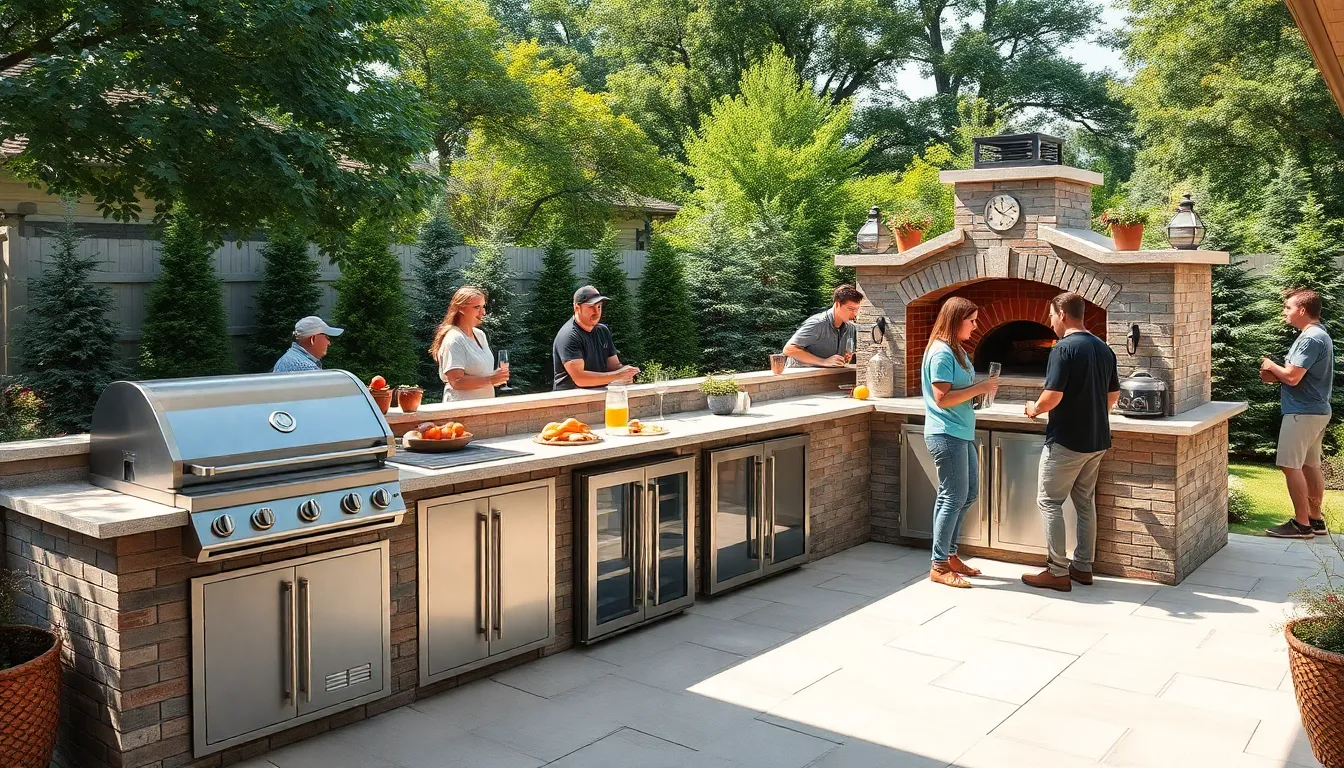
Strategic appliance placement transforms your L-shaped outdoor kitchen into a highly functional culinary workspace. We’ll explore how to maximize each component while maintaining efficient workflow.
Refrigeration Units and Ice Makers
Refrigeration units keep beverages and ingredients perfectly chilled throughout your outdoor cooking sessions. We recommend positioning these units at the end of one leg of your L-shaped layout or integrating them under the countertop to maximize space efficiency. Corner placement often works best since it provides easy access from both cooking and prep zones.
Ice makers complement your refrigeration setup by delivering fresh ice for drinks and food preparation needs. Position these units near bar seating areas or adjacent to your main grill for optimal convenience during entertaining. We’ve found that guests appreciate having ice readily available without interrupting the cooking process.
Placement strategy focuses on creating a natural flow between your cooling zones and cooking areas. Installing refrigeration units along the shorter arm of your L-shape allows you to maintain clean sightlines while keeping essentials within arm’s reach. This positioning also supports the efficient work triangle concept we discussed earlier.
Side Burners and Warming Drawers
Side burners expand your cooking capacity by allowing simultaneous preparation of multiple dishes. We suggest integrating these directly adjacent to your main grill for seamless transitions during complex meal preparation. This placement lets you move sauces, vegetables, or side dishes between cooking surfaces without losing momentum.
Warming drawers maintain optimal food temperatures while you finish preparing other courses. These appliances work best when positioned within cabinetry near your primary cooking zones for convenient access during meal service. We recommend installing them at counter height to reduce bending and improve workflow efficiency.
Workflow optimization becomes critical when combining these appliances in your L-shaped design. Position side burners on the same arm as your main grill to create a dedicated cooking zone, while warming drawers can occupy the corner area for easy access from both cooking and serving stations.
Pizza Ovens and Specialty Cooking Equipment
Wood fired pizza ovens serve as stunning focal points while delivering exceptional cooking versatility. We recommend situating these ovens at the corner of your L-shape or along one leg to balance visual appeal with practical workflow considerations. This placement creates a natural gathering spot while maintaining access to prep areas.
Specialty cooking equipment like Kamado smokers, flat top grills, and charcoal grills enhance your culinary options significantly. The L-shaped design naturally accommodates multiple cooking zones without creating crowded conditions. We suggest dedicating the longer arm to larger specialty equipment while keeping smaller appliances on the shorter arm.
Integration strategies focus on creating distinct cooking zones that don’t interfere with each other. Position your pizza oven where it can serve as both a cooking appliance and entertainment feature, allowing guests to watch the cooking process. Specialty grills work best when they have dedicated prep space on either side for ingredients and finished dishes.
Space maximization becomes effortless with proper appliance placement in L-shaped designs. The corner area provides excellent opportunities for larger appliances like pizza ovens, while the arms accommodate linear arrangements of grills, side burners, and storage. This configuration supports our goal of creating an efficient work triangle while maximizing cooking capacity.
Lighting Design That Enhances L Shape Outdoor Kitchen Functionality
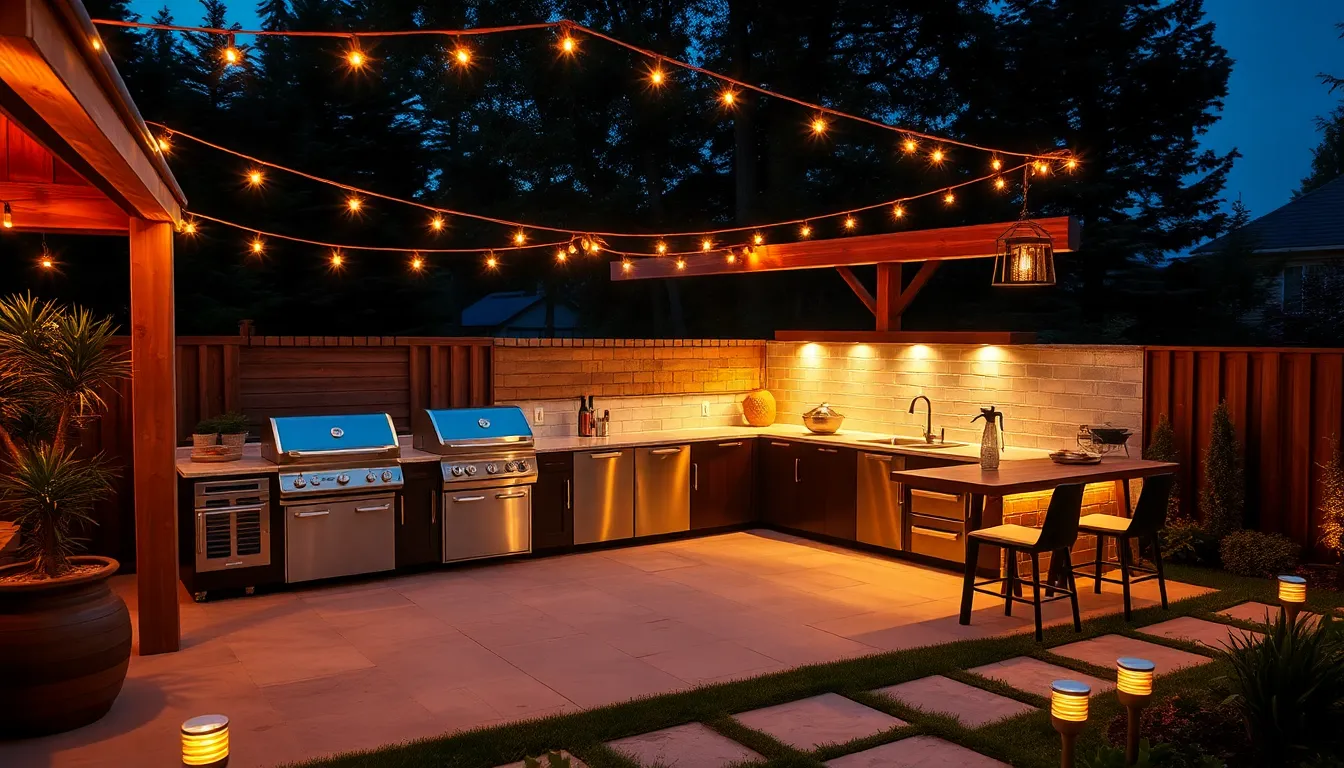
Well-planned lighting transforms your L-shaped outdoor kitchen from a daylight-only space into a versatile evening entertainment destination. Strategic illumination enhances both safety and functionality while creating the perfect ambiance for cooking and hosting guests after dark.
Task Lighting for Cooking Areas
Focused illumination over cooking zones ensures safe food preparation and grilling during evening hours. Under-cabinet LED strips provide direct light exactly where you need it most, eliminating shadows that can make chopping vegetables or monitoring grill temperatures challenging.
Adjustable spotlights mounted on overhead pergolas or canopies offer flexibility to direct bright light precisely over prep counters and cooking surfaces. These fixtures minimize glare while delivering the intense illumination required for detailed cooking tasks like seasoning meats or plating dishes.
Pendant lights suspended over bar seating areas create focused task lighting for guests who want to help with food preparation. Installing dimmer switches allows you to adjust brightness levels based on exact cooking requirements, from high-intensity grilling to gentle food warming.
Ambient Lighting for Evening Entertainment
String lights draped along the perimeter of your L-shaped kitchen create a warm, inviting atmosphere that encourages guests to linger and socialize. These versatile fixtures soften the angular lines of the L-shape design while providing gentle background illumination throughout the entire space.
Recessed LED fixtures embedded in overhead beams deliver subtle ambient lighting without overwhelming your task lighting zones. Lantern-style sconces mounted on vertical surfaces add visual interest while contributing to the overall warm glow that makes evening gatherings feel special.
Fire features like built-in torches or tabletop fire bowls provide natural ambient lighting that creates a cozy focal point within your outdoor kitchen layout. Battery-powered LED strips hidden beneath countertop overhangs offer consistent ambient lighting that won’t interfere with your cooking activities.
Safety Lighting for Walkways and Steps
Pathway lighting along routes leading to your L-shaped outdoor kitchen prevents accidents and helps guests navigate safely in low-light conditions. Low-level bollard lights positioned every 6 to 8 feet create a clear visual guide without causing glare or disrupting your kitchen’s ambient lighting design.
Recessed floor lights embedded in decking or patio surfaces illuminate level changes and steps around your outdoor kitchen without creating visual clutter. These fixtures direct light downward to enhance visibility while maintaining the clean aesthetic of your L-shaped design.
Solar-powered stake lights along garden borders and walkways provide energy-efficient safety lighting that automatically activates at dusk. Motion-activated LED strips under countertop edges offer additional safety illumination that triggers when someone approaches prep areas or storage cabinets in low-light conditions.
Roofing and Cover Options for L Shape Outdoor Kitchen Ideas
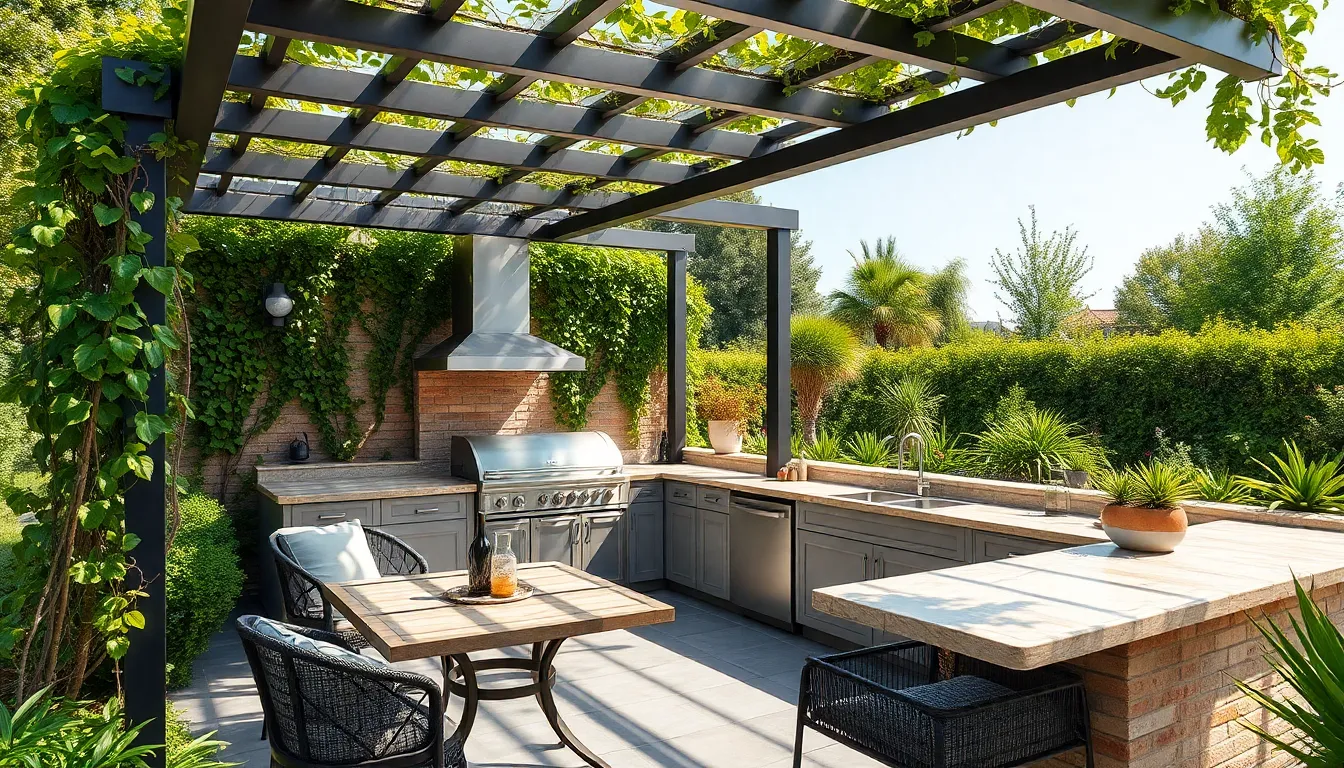
Protecting your L shaped outdoor kitchen from the elements enhances both functionality and comfort. Weather protection options range from flexible answers to permanent structures that support year-round cooking and entertaining.
Pergola and Gazebo Integration
Pergolas create an open, airy atmosphere while providing partial shade through their slatted or lattice roof design. We recommend integrating climbing plants like grape vines or jasmine to add natural shade and visual appeal to your L shaped cooking space. Fabric covers can be added seasonally for extra protection during intense summer heat.
Gazebos offer more comprehensive coverage with fully enclosed roof structures that protect against both sun and rain. Installing a gazebo over your L shaped kitchen creates an architectural focal point while enabling cooking in various weather conditions. These structures can partially or fully enclose your cooking area depending on your climate needs and design preferences.
Custom pergola designs work particularly well with L shaped layouts because they can follow the kitchen’s angular configuration. Wood pergolas complement natural stone countertops while metal versions pair beautifully with modern stainless steel appliances. Adjustable louver systems provide variable shade control throughout the day.
Retractable Awnings for Flexible Coverage
Retractable awnings deliver adjustable overhead protection that adapts to changing weather and seasonal requirements. These systems extend to cover your entire L shaped kitchen when storms approach or retract completely for stargazing during evening gatherings. Manual or motorized options accommodate different budgets and convenience preferences.
Placement considerations include mounting points that don’t interfere with cabinet doors or appliance ventilation. We suggest installing awnings that extend beyond the kitchen’s footprint to protect dining areas and guest seating. Wind sensors automatically retract motorized awnings during storms to prevent damage.
Fabric selection impacts both durability and aesthetics in outdoor environments. Solution dyed acrylic fabrics resist fading and mildew while complementing your kitchen’s color scheme. Striped patterns add visual interest while solid colors create a sleek, contemporary appearance that doesn’t compete with architectural details.
Permanent Roof Structures for Year-Round Use
Permanent roofing transforms your L shaped outdoor kitchen into a true extension of your home’s living space. Solid roof extensions or pavilion structures provide maximum weather protection while supporting electrical systems for lighting and ceiling fans. These installations enable comfortable cooking regardless of rain, snow, or intense sun exposure.
Material choices should complement your home’s existing architecture and kitchen finishes. Metal roofing offers excellent durability and comes in colors that coordinate with contemporary outdoor kitchen designs. Wood structures create warmth and can be stained to match existing deck or pergola elements.
Structural considerations include proper drainage systems and adequate support for snow loads in colder climates. Gutter installation prevents water damage to cabinets and appliances while maintaining the clean lines of your L shaped design. Incorporating skylights or clerestory windows maintains the outdoor feel while providing weather protection.
Ventilation becomes critical with permanent roofing to prevent smoke and heat buildup around cooking areas. Ridge vents or exhaust fans ensure proper airflow while maintaining the covered environment’s comfort. These systems integrate seamlessly with permanent lighting and electrical installations for a fully functional outdoor room.
Seating and Dining Areas That Complement L Shape Outdoor Kitchens
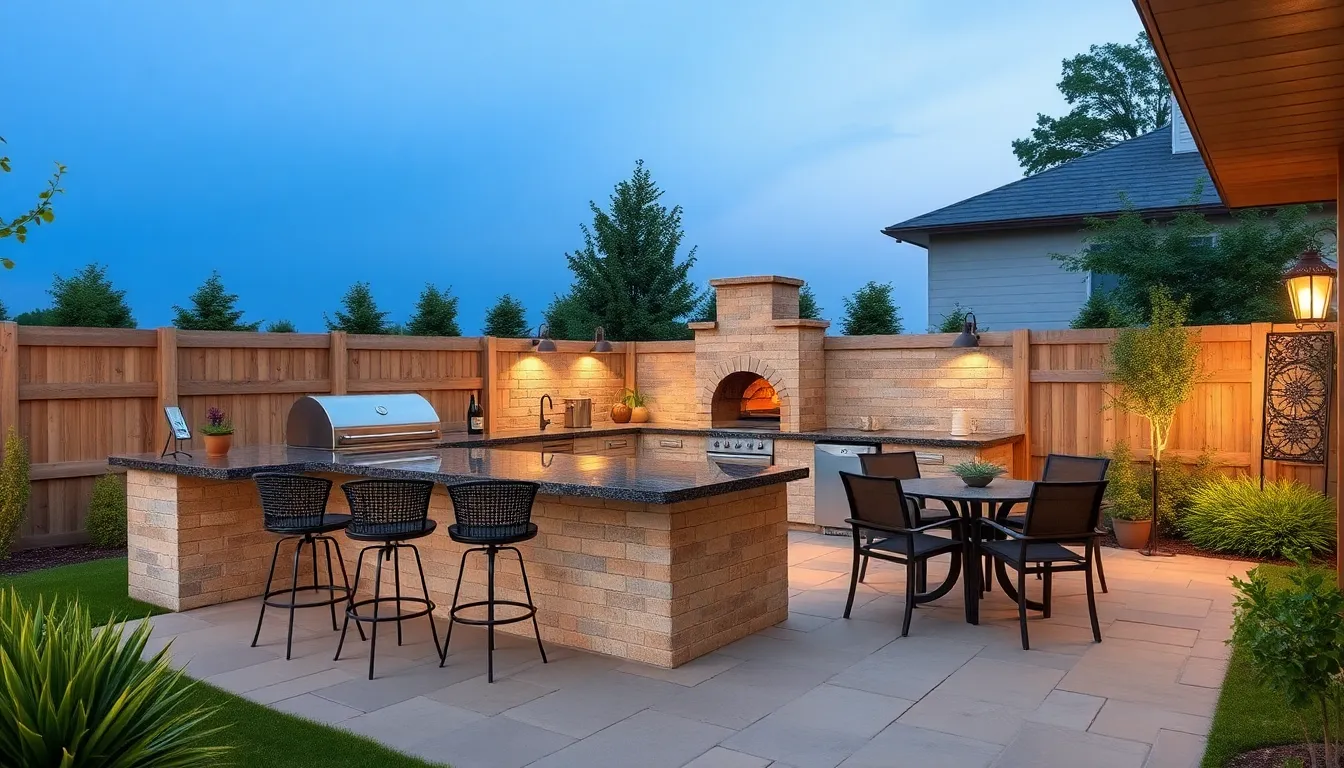
Creating the perfect seating arrangement transforms your L shaped outdoor kitchen into an interactive entertainment hub. Strategic placement of dining options enhances both functionality and social flow throughout your outdoor space.
Bar Seating Along Kitchen Islands
Bar seating creates an immediate connection between cooks and guests along one leg of your L shaped kitchen. We recommend installing wrap around bar seating that follows the natural flow of your kitchen island, allowing friends and family to gather comfortably while meals are prepared. Counter height stools or high chairs work perfectly for this setup, providing an ideal spot for casual dining and socializing.
Interactive cooking experiences become effortless when guests can watch food preparation from their bar seats. Your bar area should include integrated features like grills, pizza ovens, and serving spaces to enhance the overall guest experience. Smart positioning allows the cook to engage with visitors while maintaining full access to all cooking zones.
Design your bar seating to accommodate 3-4 people comfortably along a standard kitchen island length. Proper spacing between stools ensures everyone has adequate elbow room and easy access to drinks and appetizers during gatherings.
Adjacent Dining Table Placement
Dining tables positioned near your L shaped kitchen create a dedicated space for formal meals and larger gatherings. We suggest placing your dining table within easy serving distance while maintaining clear pathways between cooking and eating areas. This arrangement allows hosts to transition seamlessly from kitchen to table without disrupting the cooking workflow.
Coordinated materials between your kitchen and dining area enhance visual cohesion throughout the space. Natural stone countertops paired with matching table surfaces create a unified aesthetic that feels intentional and polished. Weather resistant dining sets ensure your investment withstands outdoor conditions year round.
Size your dining table based on typical guest counts, with options ranging from intimate 4 person settings to expandable tables that accommodate 8 or more diners. Strategic placement near the open end of your L shape facilitates easy serving while keeping dining separate from active cooking zones.
Lounge Areas for Casual Entertaining
Lounge seating transforms your outdoor kitchen into a comprehensive entertainment destination beyond just cooking and dining. We recommend positioning comfortable outdoor sofas or cushioned chairs to create natural conversation areas that complement your kitchen’s workflow. These relaxed seating options provide guests with a place to gather before meals or unwind after dinner.
Seamless transitions between cooking, dining, and lounging zones maximize your backyard’s functionality for various entertaining styles. Plush outdoor furniture with weather resistant cushions creates an inviting atmosphere that encourages guests to linger and socialize. Strategic placement ensures lounge areas don’t interfere with kitchen operations while maintaining visual connection to cooking activities.
Flexible furniture arrangements allow you to adapt your space for different event sizes and styles. Modular seating systems work particularly well, enabling you to reconfigure layouts based on whether you’re hosting intimate gatherings or larger parties throughout the entertaining season.
Budget-Friendly L Shape Outdoor Kitchen Ideas and DIY Options
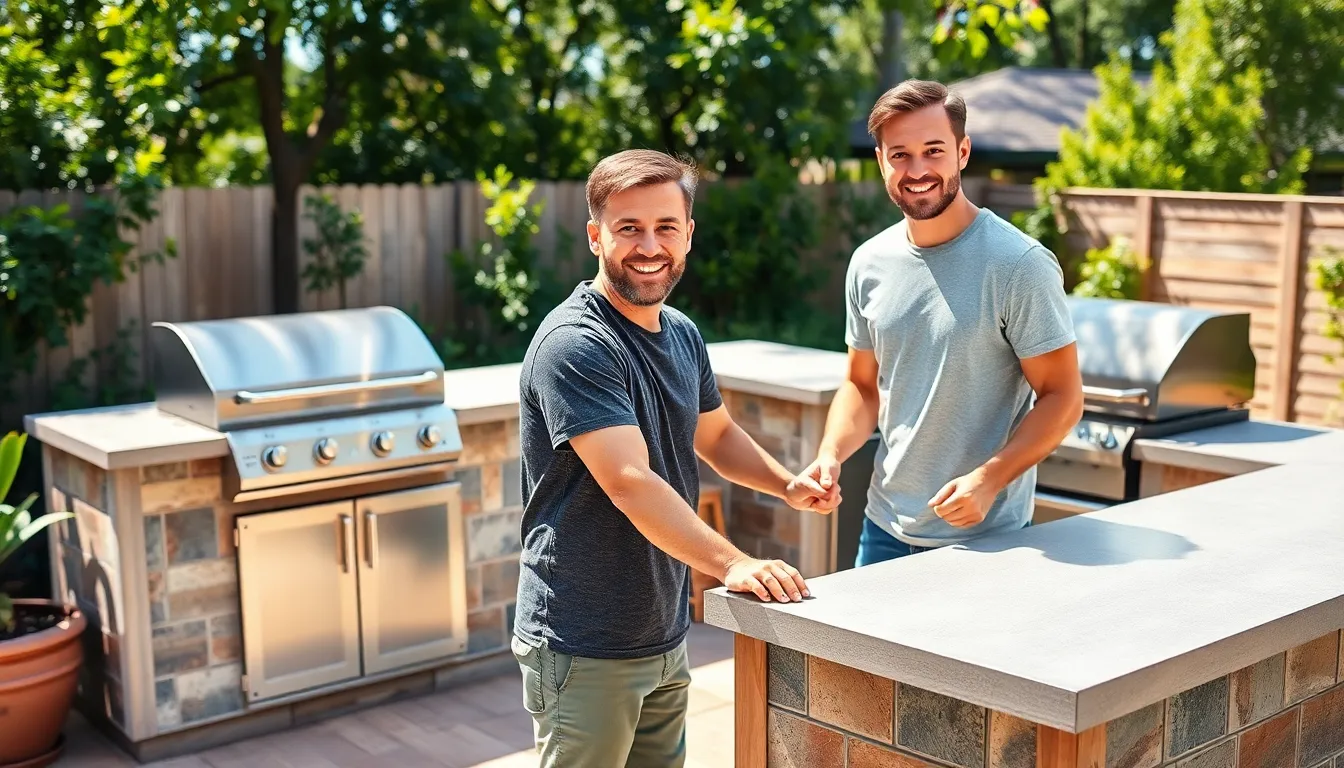
We understand that creating your dream outdoor kitchen doesn’t have to expensive. Smart planning and strategic material choices can help you build a functional L-shaped outdoor kitchen that fits your budget while delivering the entertaining space you’ve always wanted.
Modular Components for Phased Construction
Modular construction allows you to build your L-shaped outdoor kitchen in manageable phases that spread costs over time. Start with essential components like a basic cooking zone featuring your grill and prep counter, then gradually add sections such as storage units or a bar island as your budget allows.
Phased building offers the flexibility to customize your kitchen as your needs evolve and your entertaining style develops. Begin with one leg of the L-shape focusing on cooking essentials, then expand to include the second leg with additional appliances like side burners or specialized cooking equipment.
Component planning helps you prioritize which elements to install first based on your cooking habits and entertaining frequency. Essential first-phase items include the grill station and adjacent prep space, while luxury additions like wine coolers or pizza ovens can wait for later phases.
Budget spreading becomes more manageable when you divide your project into 2-3 construction phases over 1-2 years. This approach allows you to save for higher-quality materials and appliances while still enjoying your outdoor kitchen during the building process.
Cost-Effective Material Alternatives
Concrete countertops provide an affordable alternative to expensive natural stone while offering durability and customization options. These surfaces cost significantly less than granite or marble while allowing you to create unique textures and colors that complement your outdoor design.
Tile surfaces deliver aesthetic appeal and long-lasting durability at a fraction of the cost of solid stone materials. Choose from ceramic, porcelain, or natural stone tiles to create beautiful backsplashes and work surfaces that withstand outdoor conditions.
Pressure-treated wood offers an economical option for cabinetry frameworks and structural elements instead of premium hardwoods. Composite decking materials provide another cost-effective choice that resists moisture and requires minimal maintenance over time.
Budget-friendly appliances from reliable manufacturers can deliver excellent performance without premium price tags. Standard stainless steel fixtures and appliances offer durability and professional appearance while keeping your overall project costs reasonable.
| Material Type | Cost Savings | Durability Rating | Maintenance Level |
|---|---|---|---|
| Concrete Countertops | 40-60% vs Natural Stone | High | Medium |
| Tile Surfaces | 50-70% vs Solid Stone | High | Low |
| Pressure-Treated Wood | 30-50% vs Hardwood | Medium | Medium |
| Standard Appliances | 20-40% vs Premium | High | Low |
DIY-Friendly Design Elements
Simple rectangular cabinets offer straightforward construction that most homeowners can tackle with basic woodworking skills. These modular units can be assembled and finished according to your skill level and design preferences.
Pre-fabricated islands provide an excellent starting point for DIY customization with siding, tile, or stone veneers. These ready-made units save construction time while allowing you to add personal touches that match your outdoor kitchen’s aesthetic.
Accessible utility planning simplifies the installation of plumbing and electrical systems by positioning connections in easily reachable locations. Strategic placement of utility lines during the design phase makes DIY installation more manageable and reduces professional contractor costs.
Versatile surface options like tile and concrete allow you to match installation methods to your skill level and available time. These materials offer forgiving installation processes that accommodate learning curves while delivering professional-looking results.
Straightforward layouts work particularly well for L-shaped designs because they minimize complex cuts and custom fabrication requirements. The modular nature of L-shaped kitchens allows you to complete sections independently without compromising the overall design integrity.
Conclusion
We’ve explored how L-shaped outdoor kitchens can transform your backyard into the ultimate entertaining destination. From maximizing corner spaces to creating efficient work triangles these designs offer endless possibilities for both functionality and style.
Whether you’re planning a high-end custom build or working with a tight budget we’ve shown you practical answers that deliver results. The modular approach and DIY-friendly options make these outdoor kitchen dreams achievable for every homeowner.
Your L-shaped outdoor kitchen will become the heart of your outdoor living space where cooking and socializing blend seamlessly. With proper planning and the right design elements you’ll create a space that enhances every gathering and adds lasting value to your home.
Frequently Asked Questions
What makes L-shaped outdoor kitchens better than linear designs?
L-shaped outdoor kitchens create distinct zones for cooking, prep work, and serving, which enhances functionality and social interaction. The layout maximizes corner spaces and creates natural pathways for guests, making the cooking area more welcoming and efficient than traditional straight-line designs.
How do I create an efficient work triangle in an L-shaped outdoor kitchen?
Position your grill and main prep areas on the two arms of the L shape to minimize walking distances. Place the cleanup station near the corner for plumbing efficiency, and position the serving area at the open end to promote interaction while maintaining separation from cooking zones.
Where should I place different zones in my L-shaped outdoor kitchen?
Put the prep zone on the shorter arm and the cooking zone on the longer arm to accommodate larger appliances. Position the cleanup station near the corner for easy plumbing access, and place the serving area at the open end to encourage guest interaction.
What are the best grill options for L-shaped outdoor kitchens?
Gas grills work well as integrated cooking hubs with custom countertops on both sides. Charcoal grills and smokers enhance flavor and fit nicely in corner sections. Consider combining gas and charcoal options for versatility, or add wood-fired pizza ovens for comprehensive cooking capabilities.
Can I build an L-shaped outdoor kitchen on a budget?
Yes! Use modular construction to build in phases, spreading costs over time. Choose cost-effective materials like concrete countertops and tile surfaces. Start with essential components like simple rectangular cabinets and pre-fabricated islands, then add features gradually as your budget allows.
What DIY elements work best for L-shaped outdoor kitchens?
Focus on simple rectangular cabinet designs and pre-fabricated islands that allow customization without complex construction. Plan accessible utility connections to simplify plumbing and electrical installations. Use modular components that can be assembled and modified as needed.
How do I maximize storage in an L-shaped outdoor kitchen?
Utilize the corner space efficiently with rotating shelves or lazy Susans. Install storage access doors beneath grills and prep areas. Add overhead storage if you include a roof structure, and consider built-in storage within the arms of the L shape.
What’s the ideal size for an L-shaped outdoor kitchen?
Effective design matters more than size. Even small L-shaped layouts can be highly functional when zones are properly planned. Focus on creating an efficient work triangle and ensuring adequate counter space on both arms rather than maximizing overall dimensions.




